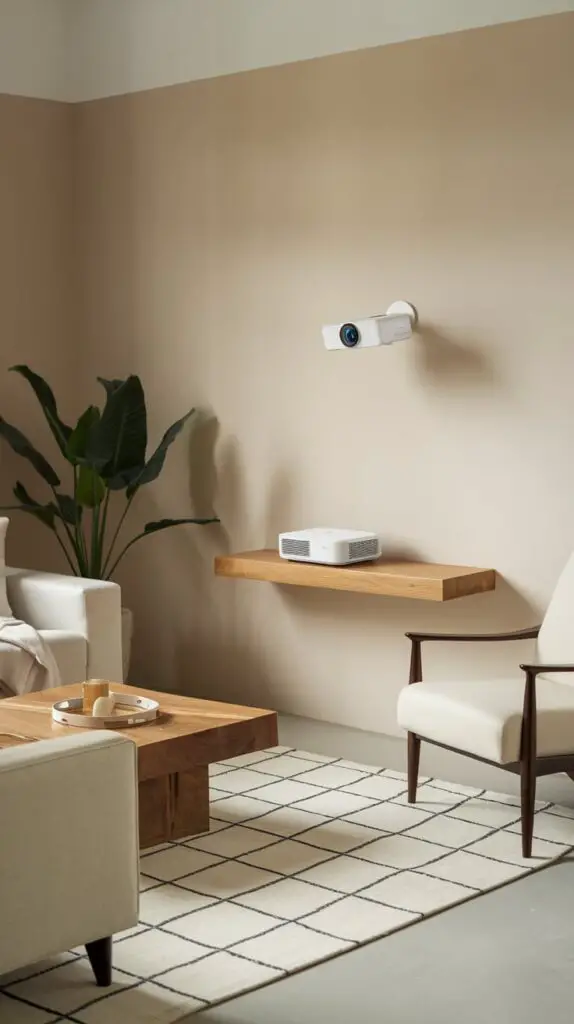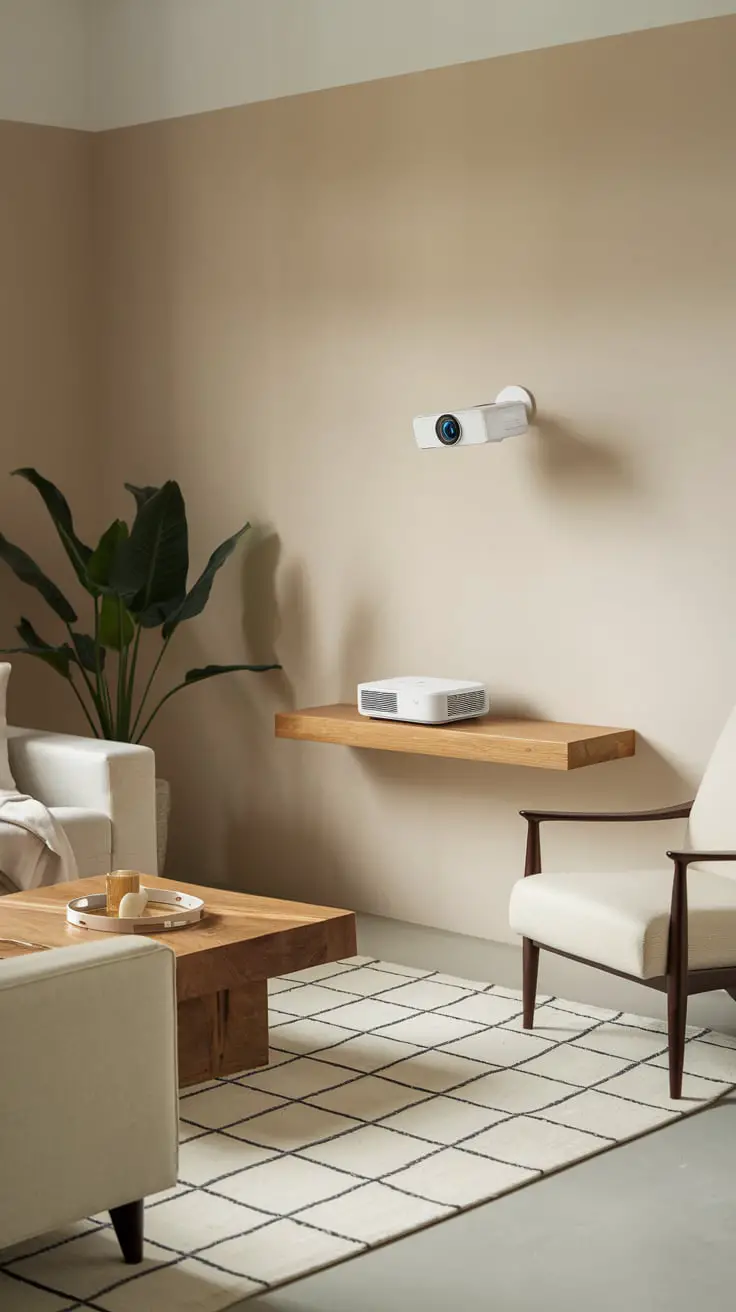Home theaters bring the magic of cinema right to your house. They offer a special place to enjoy movies, TV shows, and sports with family and friends. Many people dream of having their own home theater, and it’s easier than you might think.
A well-designed home theater can boost your home’s value and provide endless entertainment. You have lots of options when creating your perfect movie-watching space. From simple setups to high-end designs, there’s a home theater idea for every budget and taste. Let’s explore some exciting ways to make your home theater dreams come true.
1: Smart Projector
Smart projectors are changing home theaters. You can now enjoy big-screen entertainment without a TV. These devices connect to Wi-Fi and have built-in streaming apps.
Some smart projectors are portable. You can easily move them around your home or take them outside. They often have rechargeable batteries for cord-free use.
Picture quality keeps improving. Many smart projectors now offer Full HD or even 4K resolution. Some use laser technology for brighter, more vivid images.
Sound is another key feature. Many smart projectors have good built-in speakers. This means you might not need a separate sound system.
2: In-Wall Speakers
In-wall speakers offer a sleek solution for your home theater. They blend seamlessly into your walls, saving space and creating a clean look.
These speakers deliver high-quality sound without cluttering your room. You can install them in strategic locations to enhance your surround sound experience.
In-wall speakers come in various sizes and styles to fit your needs. They’re a great choice if you want powerful audio without visible equipment.
3: 4K TV
A 4K TV is a great choice for your home theater. These TVs offer stunning picture quality with four times the resolution of standard HD.
You’ll see more details and sharper images on a 4K screen. Colors look richer and more lifelike too.
Many popular streaming services now offer 4K content. This means you can enjoy movies and shows in ultra-high definition.
When shopping for a 4K TV, look at screen size and HDR support. Bigger screens work well in dedicated theater rooms. HDR enhances contrast and brightness for an even better picture.
4: Dolby Atmos Sound System
Dolby Atmos takes your home theater to the next level. This system adds overhead speakers to create a 3D soundscape.
You can set up Dolby Atmos with in-ceiling speakers or upward-firing ones. For a full setup, you’ll need a receiver that supports 11 channels.
Don’t have room for a big system? Try a Dolby Atmos soundbar. It’s a great option for smaller spaces like apartments or dorm rooms.
5: Acoustic Panels
Acoustic panels can greatly improve your home theater sound. These panels absorb sound waves and reduce echoes.
Place panels on walls and ceilings to cover about 20-30% of the surface area. Start with sidewalls at ear height when seated.
Add panels to the ceiling and back wall too. This helps control sound reflections throughout the room.
For best results, use a mix of panel sizes and thicknesses. This targets different sound frequencies more effectively.
6: Motorized Projector Screen
A motorized projector screen adds a touch of high-tech convenience to your home theater. With the push of a button, you can easily lower or raise the screen.
These screens are often hidden in the ceiling when not in use. This keeps your space looking clean and tidy.
You can control motorized screens with a remote or wall switch. Some even work with smart home systems.
When choosing a motorized screen, consider the screen material and size. Make sure it fits your room and projector setup.
7: LED Backlighting
LED backlighting can take your home theater to the next level. You can add strips of colorful LEDs behind your TV or along walls and shelves. This creates a cool glow that enhances the viewing experience.
Many LED strips let you change colors and brightness with a remote. You can match the lighting to what’s on screen or set a relaxing mood. Some even sync with the audio for an immersive effect.
LED backlights are easy to install and use little power. They’re a simple way to upgrade your home theater’s atmosphere.
8: Home Theater Recliners
Home theater recliners are a great way to make your movie room more comfortable. These seats often have adjustable angles and footrests to help you relax.
Many recliners come with built-in cup holders and arm tables. This lets you keep snacks and drinks close by while watching.
When choosing recliners, think about the size of your room. Make sure there’s enough space between rows for people to walk through easily.
Some recliners can be arranged in curved rows. This setup brings the end seats closer to the screen in wider rooms.
For the best sound, try to avoid fully lying down in your recliner. A slightly upright position usually works best for enjoying movies.
9: Universal Remote Control
A universal remote control can simplify your home theater setup. It lets you manage multiple devices with one device.
Many universal remotes can control TVs, cable boxes, and streaming devices. Some newer models even work with smart home gadgets.
Look for remotes with easy setup and a comfortable design. Features like voice control or backlit buttons can be handy too.
Consider how many devices you need to control when choosing a remote. This will help you pick one that meets your needs.
10: Media Server
A media server can be a game-changer for your home theater setup. It lets you store and access all your digital movies, TV shows, and music in one place.
You can build a media server using a dedicated computer or a network-attached storage (NAS) device. Pick one with enough storage for your needs and connect it to your home network.
Popular media server software options include Plex, Emby, and Jellyfin. These organize your files and make them easy to browse on your TV or other devices.
With a media server, you can say goodbye to physical discs and enjoy your entire media library at the touch of a button.
11: Popcorn Machine
A popcorn machine brings the authentic movie theater experience to your home. You can choose from countertop models or larger freestanding units.
Look for machines with a kettle size that matches your needs. A 4-ounce kettle produces about 4 quarts of popcorn.
Features like built-in warmers keep your popcorn fresh. Some models have old-fashioned designs that add retro charm to your space.
For best results, use coconut oil and theater-style popcorn salt. This combo creates that classic movie theater taste and aroma in your home.
12: Wireless Subwoofer
A wireless subwoofer can be a great addition to your home theater. It gives you more flexibility in placement without messy cables running across the room.
Wireless subwoofers connect to your audio system using radio frequencies. This lets you put the subwoofer anywhere in the room for optimal sound.
Many top audio brands now offer wireless subwoofer options. Look for models with good power output and a range that works for your space.
You’ll need to plug the subwoofer into a power outlet. But you won’t have to run audio cables from your receiver to the sub.
13: Surround Sound Receiver
A surround sound receiver is the heart of your home theater setup. It processes audio signals and sends them to your speakers.
Most receivers support 5.1 or 7.1 channel configurations. This means 5 or 7 main speakers plus a subwoofer.
Some high-end models can handle up to 11.4 channels. This allows for even more immersive sound with extra height and rear speakers.
When choosing a receiver, look for one that matches your speaker setup and room size. Make sure it has enough power to drive your speakers effectively.
14: Streaming Stick
A streaming stick is a small device that plugs into your TV’s HDMI port. It lets you watch shows and movies from popular streaming services.
Popular options include Roku, Amazon Fire TV, and Google Chromecast. These devices support 4K and HDR for great picture quality.
Streaming sticks are easy to set up and use. They’re also portable, so you can take them when traveling. With a streaming stick, you can turn any TV into a smart TV for your home theater.
15: Blu-ray Player
A Blu-ray player is a must-have for any home theater setup. It delivers high-quality video and audio for an immersive movie experience. Look for a 4K Ultra HD Blu-ray player to get the best picture quality.
Choose a player with smart features like streaming apps and WiFi connectivity. This lets you access online content easily. Make sure it has HDMI outputs to connect to your TV and sound system.
Some Blu-ray players have built-in upscaling to improve the look of standard DVDs. Consider models with 3D playback if you enjoy 3D movies at home.
16: Wall Mount Kit
A wall mount kit is a great choice for your home theater setup. You can attach your TV or projector screen securely to the wall. This saves floor space and gives your room a clean look.
Wall mount kits come in different styles. Some are fixed, keeping the screen in one position. Others tilt or swivel, letting you adjust the viewing angle.
Before buying, check your TV’s size and weight. Make sure the mount can support it. You’ll also need to find wall studs for a strong installation. With the right tools and some DIY skills, you can install a wall mount kit yourself.
17: Gaming Console
A gaming console can transform your home theater into a multi-purpose entertainment hub. You can easily connect your favorite console to the big screen for an immersive gaming experience.
Choose a spot near your TV for the console and controllers. Make sure there’s enough space for players to move around comfortably.
Consider adding a storage unit to keep games and accessories organized. This will help keep your home theater tidy and clutter-free.
18: Soundproof Curtains
Soundproof curtains can greatly enhance your home theater experience. These special curtains help block outside noise and improve sound quality inside your viewing space.
Look for curtains made with heavy-duty materials like vinyl, fiberglass, or polyester. The best options have multiple layers for maximum sound absorption.
Some curtains can block up to 60% of outside noise. As a bonus, they often darken the room and provide insulation, potentially lowering your energy bills.
When choosing soundproof curtains, consider both function and style. Many options look great while still providing acoustic benefits for your home theater setup.
19: Media Cabinet
A media cabinet is a smart addition to your home theater. It keeps your equipment organized and hidden from view. You can store your cable box, gaming consoles, and DVD player neatly inside.
Choose a cabinet that matches your room’s style. Wood cabinets add warmth, while sleek metal designs look modern. Make sure it has enough shelves and compartments for all your gear.
Look for cabinets with built-in cable management. This helps keep wires tidy and out of sight. Some cabinets also have ventilation to prevent overheating.
20: Smart Lighting System
Smart lighting systems can make your home theater experience better. You can control the lights with your phone or voice. This lets you set the perfect mood for movies or games.
These systems often have color-changing bulbs. You can pick from millions of colors to match what’s on your screen. Some lights even sync with your TV to change with the action.
You can also set up different light scenes. One for watching movies, another for gaming, and one for when you’re not using the theater. This makes it easy to switch between activities.
21: Custom Cabinetry
Custom cabinetry can elevate your home theater’s style and functionality. You can design cabinets to fit your specific needs and space.
Built-in storage keeps your media and equipment organized. You might include shelves for DVDs, drawers for remotes, and compartments for gaming consoles.
Consider adding a mini-fridge or snack drawer for movie night treats. Custom cabinets can also hide speakers and wires for a clean look.
Choose materials and finishes that match your theater’s design theme. Wood, metal, or glass elements can create a unique aesthetic.
22: Artwork Panels
Artwork panels are a great way to add style to your home theater while improving sound quality. These panels combine beautiful designs with sound-absorbing materials.
You can choose from many styles, like abstract patterns or nature scenes. The panels come in different sizes and shapes to fit your space.
Hang them on the walls or ceiling to reduce echoes and make your movie sound better. They’re an easy way to upgrade your home theater’s look and sound at the same time.
23: HDMI Switcher
An HDMI switcher is a must-have for your home theater setup. It lets you connect multiple devices to one TV or projector.
You can hook up your gaming consoles, cable box, and streaming devices all at once. No more unplugging and plugging cables when you want to switch sources.
Most HDMI switchers support 4K resolution and HDR. Some even work with 8K. Look for one with enough ports for your needs.
Many switchers come with a remote control for easy switching. Some can automatically detect when a device turns on and switch to it.
24: Bass Traps
Bass traps are special acoustic panels that help control low-frequency sound in home theaters. They reduce boomy bass and improve overall sound quality.
You can place bass traps in room corners where bass tends to build up. They come in different sizes and shapes to fit your space.
Some bass traps are made of foam, while others use wood panels or membrane absorbers. You can buy pre-made bass traps or build your own using plywood and insulation.
Adding bass traps to your home theater can make a big difference in how music and movies sound. They help create a more balanced and enjoyable listening experience.
25: Theater-Style Carpeting
Theater-style carpeting can enhance your home theater experience. It absorbs sound and reduces echoes, creating better acoustics in the room.
Choose a dark color like deep blue or burgundy to mimic real movie theaters. This helps minimize light reflection and improves the visual experience.
Look for carpets with plush, thick pile. They’re comfortable underfoot and provide extra sound insulation. Some options even have special designs inspired by classic theater carpets.
When selecting carpet, consider durability too. Your home theater will see a lot of use, so pick a material that can stand up to foot traffic and spills.
26: Smart Thermostat
A smart thermostat can enhance your home theater experience. You can adjust the temperature without leaving your seat. These devices connect to your Wi-Fi network for easy control.
Many smart thermostats work with voice assistants like Alexa or Google. This lets you change settings hands-free. Some models even learn your preferences over time.
You can set schedules to optimize comfort during movie nights. Smart thermostats also help save energy when the room is not in use.
27: Universal Media Server
Universal Media Server is a great option for your home theater setup. It lets you stream movies, TV shows, and music to different devices in your home.
You can easily set it up on your computer or network storage device. It works with many types of media players and game consoles.
Universal Media Server automatically organizes your media files. This makes it simple to find and play what you want. It also supports a wide range of file formats.
28: Ceiling-Mounted Projector
A ceiling-mounted projector can transform your home theater. You’ll save space and get a cleaner look compared to a tabletop setup.
Choose a spot on your ceiling that gives the best viewing angle. Make sure it’s close to a power source.
You can buy a mount or make one yourself. DIY options include using wood, metal pipes, or even repurposed shelves.
Remember to measure carefully before installing. The right height and distance from the screen are key for the best picture.
29: AI Voice Assistant
You can add an AI voice assistant to your home theater setup. It lets you control things with just your voice. You can ask it to turn on the TV, play a movie, or adjust the volume.
Some popular options include Amazon Alexa, Google Assistant, and Apple’s Siri. These work with many smart home devices. You can also create a custom assistant using platforms like Home Assistant.
Voice control makes your home theater more convenient and futuristic. It’s especially helpful when your hands are full or you can’t find the remote.
30: Wireless VR Headset
A wireless VR headset can add immersion to your home theater. You can explore virtual worlds without being tied down by cords.
The Meta Quest 3 is a popular standalone headset. It offers high-quality visuals and hand tracking without needing a PC.
You can use VR headsets to watch movies on a virtual big screen. Some also let you play games or attend virtual events.
When choosing a VR headset, look for comfort, battery life, and content libraries. Consider your space and budget too.
Optimal Placement for Your Home Theater
The right placement makes a big difference in your home theater setup. It affects how well you can see the screen and hear the sound. Let’s look at how to choose the best room and where to put your screen.
Room Selection and Layout
Pick a room that’s quiet and easy to make dark. A basement or spare bedroom often works well. Make sure the room is big enough for your gear and seating.
Measure the space and plan where everything will go. Leave room to walk around. Put your main seats 10-15 feet from the screen. This gives you a good view without straining your neck.
For surround sound, place speakers around the room. Put the center channel below or above the screen. Put the left and right speakers on each side at ear level when seated. Place surround speakers to the sides or slightly behind your seats.
Screen Positioning
Mount your screen or TV at eye level when you’re sitting down. This helps prevent neck strain during long movie sessions.
If you use a projector, make sure the screen is centered on the wall. The bottom of the screen should be about 24-36 inches from the floor. This height works well for most setups.
For the best view, sit about 1.5 to 2.5 times the screen width away. So for a 65-inch TV, sit 8-13 feet back. Adjust based on what feels comfortable for your eyes.
Make sure there’s no glare on the screen from windows or lights. Use curtains or blinds to control outside light. This helps you see the picture clearly at any time of day.
Essential Home Theater Components
A great home theater setup relies on key equipment to create an immersive experience. The right audio system and display are crucial for bringing movies and shows to life in your own space.
Audio Systems and Speakers
A quality audio system is vital for a true cinematic experience. Start with a powerful AV receiver to process audio signals. For surround sound, you’ll need at least 5 speakers – left, right, center, and two rear channels. A subwoofer adds deep bass for explosive effects.
Soundbars offer a simpler alternative if space is limited. They provide good audio in a compact package. For the best sound, place speakers at ear level when seated. Avoid putting them in corners or behind furniture.
Consider room acoustics too. Carpets and soft furnishings help absorb echoes. Sound-absorbing panels on walls can further improve audio quality.
Projectors vs. Televisions
Your choice of display depends on room size and budget. Projectors offer the biggest screens, often 100 inches or more. They work best in dark rooms with light control. Look for models with at least 1080p resolution and 2000 lumens brightness.
TVs are better for brighter rooms. They offer sharper images and don’t require separate screens. 4K TVs provide stunning detail, while OLED models excel in contrast and black levels. For screen size, aim for at least 50 inches in most rooms.
Consider viewing distance when choosing. Sit closer to smaller screens to feel more immersed. With larger displays, you can sit farther back for comfort.
Enhancing Your Home Theater Experience
A great home theater combines top-notch audiovisual elements with comfort and ambiance. Two key areas to focus on are acoustic treatments and seating options. These can take your setup from good to amazing.
Acoustic Treatments
Sound quality is crucial for an immersive movie experience. Acoustic panels help control echoes and improve clarity. Place them on walls and ceilings to absorb sound waves. Thick curtains and carpets also reduce reflections.
Bass traps in room corners tame low-frequency rumble. Diffusers scatter sound waves, creating a more balanced listening environment. Don’t forget about soundproofing – add insulation to walls and use solid core doors to keep noise in.
Consider professional acoustic analysis to pinpoint problem areas. This lets you target treatments for the best results. Even small changes can make a big difference in sound quality.
Seating and Comfort
Comfy seating is a must for long movie sessions. Recliners with cup holders and snack trays are popular choices. Look for seats with good lumbar support and headrests.
Tiered seating improves sightlines for everyone. Risers can be built or bought pre-made. Make sure there’s enough space between rows for easy movement.
Add some variety with love seats or a cozy sofa in the front row. Bean bags or floor cushions give kids flexible seating options.
Don’t forget about lighting. Dimmable lights or LED strips create the right mood without causing glare on your screen. Remote-controlled options make adjustments easy from your seat.





